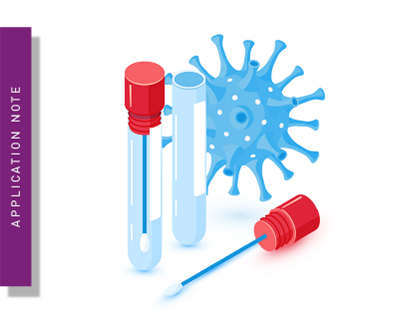
NextGenPCR™ evaluated with a fluorescence microplate reader accelerates testing for SARS-CoV-2 viral RNA
NextGenPCR™ evaluated with a fluorescence microplate reader accelerates testing for SARS-CoV-2 viral RNA


Viruses cause disease but also serve as useful tools for research. Learn how BMG LABTECH microplate readers can advance viral research and explore some of the many possibilities for applications.
Viruses are equally a threat to plants, bacteria, animals, and humans. They use their hosts to reproduce and can thereby damage them. This can lead, for example, to crop or farm animal losses and pandemics. On the other hand, viruses serve as tools for genetic engineering and the targeted modification of genomes.
Modern virology characterises viruses molecularly and functionally and uses this information to develop diagnostic tests, antiviral drugs and vaccines. Gene reporter assays can also be used to study how viruses infect cells and how viral and cellular genes are expressed after infection. Nowadays, microplate-based assays on how to detect a virus increase throughput and enable the measurement of viral cytopathic effects, virus neutralization, antibacterial effects, binding of molecules to viral particles and much more.
Virus assays range from simple ELISA assays for measuring antibody titer to live-cell assays to measure replication. The variety of virus assays in combination with the need for cell-based methods requires a flexible microplate reader.
The CLARIOstar®Plus microplate reader offers this flexibility. It is a modular multi-mode reader that can be equipped with fluorescence, luminescence, absorbance and advanced detection modes. With its Atmospheric Control Unit, it is further optimized for live-cell assays as it creates the optimal environment for long-term cell-based experiments. The CLARIOstar Plus can be equipped with a red-shifted PMT for increased sensitivity with fluorophores emitting in the red range of light. These are often used in cell assays to avoid autofluorescence.
The PHERAstar FSX multi-mode microplate reader is the ideal platform for screening departments, where potential anti-viral compounds have to be detected quickly and efficiently in high throughput. In addition, it can quickly and effortlessly measure all FRET, TR-FRET and fluorescence polarization dual emission assays. These are often used in binding/interaction assays for anti-viral compound screens.
Several of BMG Labtech’s readers like the Omega series or the CLARIOstar Plus offer an optional extended incubation up to 65 °C. This feature enables to simultaneously incubate and analyse isothermal amplification assays like the Loop-mediated isothermal amplification (LAMP). This function has been used in the application note 356 to run and detect a colorimetric LAMP assay for the detection of SARS-CoV-2.
To learn more about virus detection methods and how to detect a virus with a microplate reader check out our blog post on the topic.
Browse our resources section for information about specific applications, literature citations, videos, blog articles and many other publications. Many of the resources provided are associated with current and previous instrument models and versions.
NextGenPCR™ evaluated with a fluorescence microplate reader accelerates testing for SARS-CoV-2 viral RNA
Are you looking for a label-free method to study potential antiviral drugs? This AppNote presents a fast and cheap way to study viral cytopathic effects with cell viability/toxicity assays.
Are you looking for an easy way to screen for antivirals in 384-well format? This application is ideally suited to investigate virus uptake and replication in living cells.
LAMP represents a promising alternative to PCR. Read here how LAMP amplification assays can be performed and detected in real time using the 65°C heating capability of the Omega Series.
Looking for methods to study the molecular mechanisms of viral replication? In this AppNote a fluorescence-based approach for real-time measurement of viral gene expression is presented.
Fluorescence polarization detection with the CLARIOstar® microplate reader to investigate influenza virus’s RNA polymerase activity is highly sensitive and HTS-compatible. Read more here.
Gene reporter assays are sensitive and specific tools to study the regulation of gene expression. Learn about the different options available, their uses, and the benefits of running these types of assays on microplate readers.
Do you want to study viral infectivity and screen for anti-virals? This blog post highlights the advantages of TCID50 assays for the determination of viral titers in microplate format.
This blog highlights some alternative viral detection methods to PCR. Find out, which can be run on microplate readers and what advantages the readout in microplates offers.
This blog article highlights different approaches on how microplate readers can be used for the detection of viruses. Read more here.
The dangerous viral outbreaks of recent years, such as SARS-CoV-2, illustrate the intensive research that virology requires. Find out more about available virus assays here.
Vaccines are powerful tools to fight viral diseases. Read more about the science behind vaccines and what we can expect from vaccine development in the future.
Interested in the acceleration possibilities in the process of drug approval? Daniel Thomas from Arctoris suggests possible entry points based on the example of drugs against SARS-CoV-2.
Ahlam Ali from Queen’s University Belfast, UK shows results from a screen for antiviral and anti-inflammatory activity against SARS-CoV-2, using a drug repurposing approach.
RNA-binding proteins play an important role in host-virus interaction. Learn here, how these interactions can be studied to find new potential drug targets to fight viral infections.
Joao used a CLARIOstar Plus and a PHERAstar FSX, for assay development and compound screening against a viral exonuclease.
Alfredo Castello-Palomares from Oxford University talks about identifying and characterizing cellular RNA-binding proteins required for viruses to spread.
Most flexible Plate Reader for Assay Development
Powerful and most sensitive HTS plate reader
Flexible microplate reader with simplified workflows
Upgradeable single and multi-mode microplate reader series